The humble status of mince, so often the final resting place for old meat scraps or less glamorous cuts, is summed up perfectly by one of my favourite Scottish expressions, “thick as mince”, yet because it’s both quick and economical to put on the table, workaday mince plays a central role in some of the world’s best-loved home cooking. Think Scottish stovies, or Danish frikadeller, or Thai pad krapow – or, our subject today, the keema enjoyed in various forms throughout the Indian subcontinent. Baked into naan, folded into scrambled eggs or spilling out of a soft white pav, or bun, keema is prepared in a myriad ways, but for some reason it’s hard to find in restaurants near where I live in north London. Happily, it’s a great pleasure to make at home.
(Note that this recipe is very much a jumping-off point; though I didn’t have time to try them all, I’ve also earmarked, for ongoing research: Maunika Gowardhan’s grandmother’s version with coconut milk and vinegar, Cyrus Todiwala’s version with scrambled egg, Asma Khan’s Armenian-inspired dill pilau, the orange-juice-flavoured recipe that Madhur Jaffrey got from a Hyderabadi at a film director’s dinner party and Saliha Mahmood Ahmed’s modern Mughal take with almonds and white poppy seeds. The future’s bright; the future’s mince.)
The meat
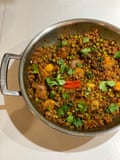
Unsurprisingly, a keema stands or falls on the quality of its meat – it’s usually made with lamb or mutton, but beef keema is also found in communities where the cow is eaten (Mallika Basu has a recipe for it in her book Masala). My own preference, however, is for sheep, whose more robust flavour, I find, better holds its own against the spices.
Roshan Hirani, whose recipe appears in the Cooking with my Indian Mother-in-Law book she co-authored with Simon Daley, cautions that you should “use the best, leanest minced lamb you can find for this curry, and you’ll be rewarded with a rich, velvety sauce”. Baljinder Kaur calls for minced lamb leg, another pretty lean cut, on her Authentic Punjabee blog (though she also adds marrow, of which more shortly), while the Dishoom cookbook reckons keema is a dish that “relies on lamb mince with a decent level of fat”. I’m firmly in the latter camp – to my mind, a good keema should have a rim of delicious orange oil around the rim, as in many of the examples shown in Conde Nast Traveller India’s round-up of Mumbai’s best keema pavs (I use mince that’s roughly 20% fat).
Kaur adds lamb leg bones to the pan in tribute to her late father, who “totally appreciated the gravy that was created from the marrow bone of the lamb pieces … cooking it down on a low heat until it melts into the dish gives it such a rich, deep flavour”. Gowardhan tells me that when her own mother cooked keema, she’d sometimes include chicken liver or bone marrow, which “gave a lovely, rich flavour”. If you can get hold of some lamb marrow bones, she suggests simmering them in 150ml water and adding them and the water to the pan (or you can just chuck them in, as Kaur does, but make sure they’re at least partly submerged to get the most benefit).
Spicing

Sumayya Usmani, who writes in her book Summers Under the Tamarind Tree that keema is found “in every home in Pakistan, from the most humble to the most extravagant”, starts by infusing the oil with a whole garam masala of peppercorns, cloves, black cardamom pods, cumin and coriander seeds, star anise, bay leaves and a cinnamon stick. Though I’m sold on the sweet warmth these whole spices lend the dish, like Hirani and chef Atul Kochhar, I’ve gone for a slightly pared back selection to make room for the fresh herbs I’ll also be using.
Later in the cooking process, bitter turmeric and hot chilli are the most common additions, while Hirani pops in madras curry powder and paprika and Dishoom bay leaves, but I’ve kept things simple with some savoury cumin and zesty coriander.
Aromatics and vegetables

All the keema recipes I try kick off with sauteed onion (I love the sweetness of Usmani’s red ones) cooked with fresh ginger and often garlic, too. Kaur and Dishoom add fresh green chillies, whose herbaceous heat supplies a welcome bitter note, with the latter using them in a puree with fistfuls of fresh mint and coriander. The contrast of these fresh flavours with the gorgeously oily meat, sweet onion and spices takes an already delicious dish to another level, as far as I’m concerned, particularly with a final spritz of tangy lime juice.
Hirani bulks out the dish with potatoes, which absorb some of the spicy oil to satisfying effect, but the peas I’m more familiar with are still my favourite bonus vegetable; their sweet bounciness just works somehow. Usmani, Hirani, Kaur and Kochhar include tomatoes, which gives their keemas a richly savoury, umami quality, but having gone down the herb route, I don’t want to overwhelm the lamb. That said, I wonder if the acidity of those tomatoes works to soften the meat, much as Dishoom’s more neutral yoghurt does. (They also add a little flour to “lock in the moisture”, giving their keema a wonderfully juicy quality that I’m very much here for.)
Finishing touches

I’m very taken with Usmani’s final flourish: she adds a white-hot piece of charcoal to the pan with a lick of ghee, then leaves the smoke to infuse the meat before serving. It really is extraordinarily good, so if you happen to have a lump handy and can wait an extra 15 minutes to tuck in, I’d highly recommend it.
Keema is often served with chopped onion and herbs, fresh chillies, lime wedges and bread to scoop it up with, or dolloped into a soft white buttered roll, though Asma Khan puts hers in a toastie. Whatever you pair it with, I defy you not to mop the plate.
Perfect keema
Prep 15 min
Cook 50 min
Serves 4
2 tbsp neutral oil
6 black peppercorns
1 black cardamom pod, lightly crushed
3 green cardamom pods, lightly crushed
1 small piece cinnamon stick
1 tsp coriander seeds
½ tsp cumin seeds
1 large red onion, peeled and finely chopped
4 large garlic cloves, peeled and crushed or grated
1 tbsp finely grated root ginger
2 green finger chillies, one finely chopped, the other slit lengthways
½ tsp ground coriander
½ tsp ground cumin
100g Greek or thick whole milk yoghurt
500g minced lamb or mutton, preferably about 20% fat
1 tsp fine salt
½ tsp plain flour, or cornflour
5 tbsp (10g) fresh mint leaves, finely chopped
5 tbsp (20g) fresh coriander leaves and stems, finely chopped
100g frozen peas
Heat the oil in a wide, heavy-based pan over a medium-high heat, add the whole spices and fry until aromatic.
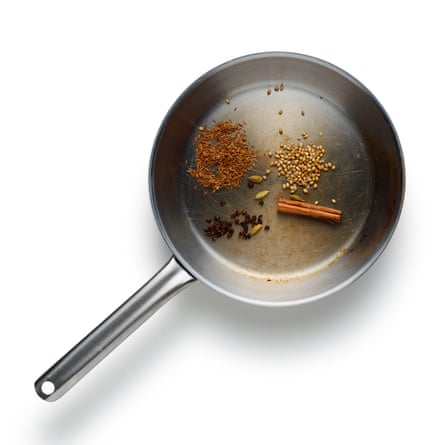
Turn down the heat to medium-low, add the onion and cook, stirring regularly, until soft and starting to brown.
Stir in the garlic, ginger and chopped chilli, fry, stirring, for a couple of minutes, then add the ground spices and fry for another minute.

Turn the heat back up to medium-high, stir in the yoghurt and cook for two to three minutes, until it begins to separate.
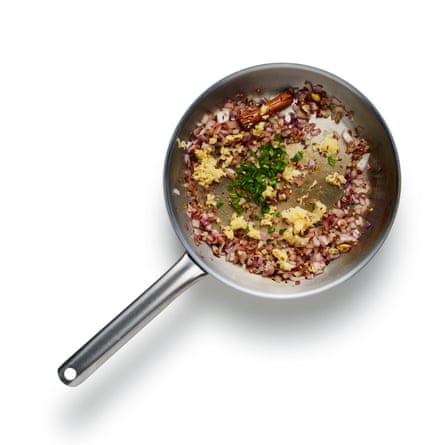
Stir in the lamb, salt and whole slit chilli, turn down the heat a bit and cook until the mince begins to release its juices.
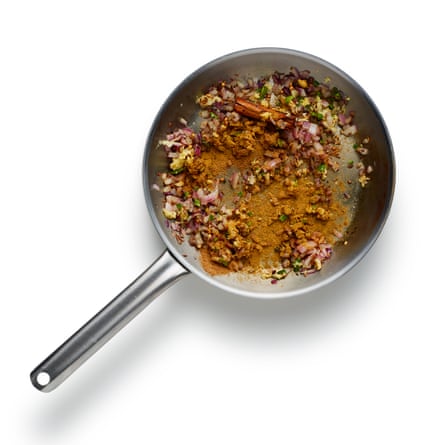
Sprinkle the flour over the top and stir in, turn the heat right down and leave to cook for 20 minutes.
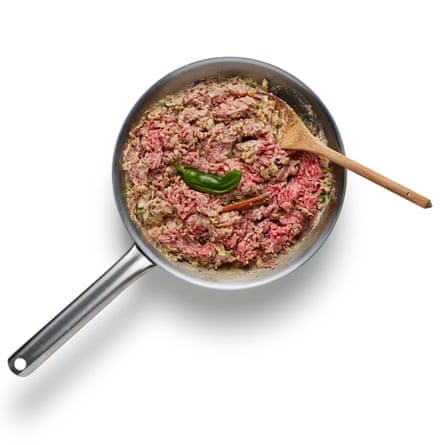
Stir in the chopped herbs and peas, simmer for another 15 minutes, then serve as above.

Keema: what’s your favourite recipe to cook at home, and, at a time when travel is but a distant dream, where’s your favourite place to go out and eat it?
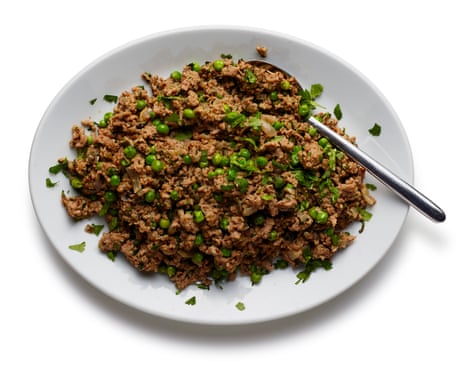
Comments (…)
Sign in or create your Guardian account to join the discussion